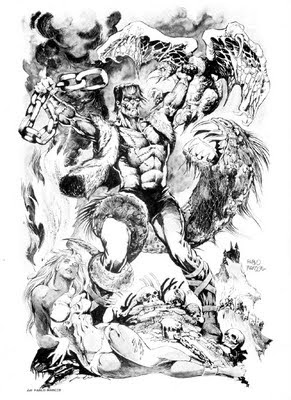The Essential Monster of Frankenstein (Marvel Comics, 2005)
Writers: Gary Friedrich, Doug Moench and Bill Mantlo
Artists: Mike Ploog, John Buscema, Val Mayerik, et.al.
Rating: Seven of Ten Stars
I suspect that most people reading this first came to Frankenstein's Monster through the movies, be they the Hammer films or the ones from Universal Pictures. Myself, my first exposure to Frankenstein's Monster was in the pages of a comic books where in one issue I read about him fighting a giant spider while looking for the man who created him, and then later fought vampires and ultimately did come face-to-face with his maker.
These two issues helped fuel my love of comics, as random as they were in the overall placement of the Marvel Comics' version of Frankenstein's Monster, so when I saw Marvel was collection ALL the stories in one big fat book, I had to have it, so I could read the rest of the story, even if it was three decades later.
This mammoth black-and-white reprint volume features some of very best comics published by Marvel... and some of the very worst. It collects all the early of Frankenstein's Monster as seen through the prism of the House of Ideas, presenting material that original appeared in "Monster of Frankenstein," "The Frankenstein Monster," Legion of Monsters," and "Monsters Unleashed."

The tales within its pages that have Gary Friedrich credited as writer are true gems of comic story-telling. From the fabulous adaptation of Mary Shelley's novel, to the inevitable battle between gothic horror titans Dracula and Frankenstein's Monster, through the tragic conclusion of the monster's quest to find the Last Frankenstein, the first 11 issues of the Monster of Frankenstein comic book are indeed "essential" reading. Friedrich's stories are well-crafted, the 19th century setting refreshing, the characters all interesting, and the illustrations for those tales, primarily by Mike Ploog and John Buscema, are also among some of the finest work those artists ever did.
The same is true of the first few reprints featuring Frankenstein's Monster from the pages of Monsters Unleashed. The saga of Frankenstien's Monster is moved into the modern day as an obsessive mad scientist discovers the inert creature in a traveling sideshow and revives him with bizarre and tragic consequences. The first few of these stories were written by Gary Friedrich and illustrated by John Buscema, and these, again, are true comic-book classics. But once Friedrich leaves as writer, the quality goes down the drain.
With the exception of the final story in the collection, the episodes penned by Doug Moench are just plain awful, with Frankenstien's Monster facing off against a silly secret criminal organization and even sillier by-products of the efforts of modern-day monster-builders. I hate to say that Moench turned in bad work for the series, as he has written some of my favorite comics ("Master of Kung-Fu," "Six From Sirius," his run on "Catwoman"), but there is just nothing redeeming about his efforts on the Frankenstien series. (Except the very last story reprinted from "Legion of Monsters". Moench and the artist he was teamed with on the strip, Val Mayerik, do their only decent work for the entire series on that one.)
In the final anaylsis, about 1/3rd of this book is trash, but the good parts are really good and this makes "Essential Monster of Frankenstein" a worthy addition to any fan of horror comics' bookshelf. Just skip the material that originally appeared in The Frankenstein Monster issues 12-18 and Monsters Unleashed issues 6-9.
Unfortunately, Marvel Comics has chosen not to keep the book in print. It's too bad, because, although flawed, It's worth seeking out, and I recommend getting a copy from some source before "collector prices" truly start kicking in.





















.jpg)






.jpg)
